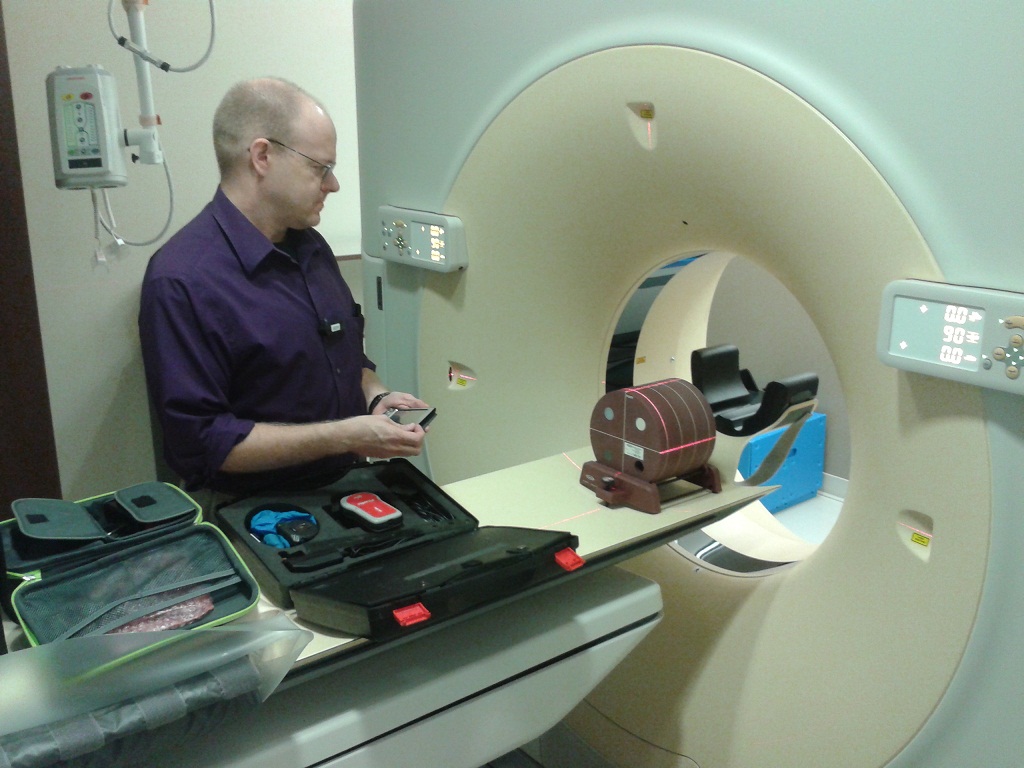It's important to us to keep you informed about changes in medical physics regulations -- and it's also our pleasure to keep you informed as part of our commitment to customer service.
Read our blog often for the latest updates and expert medical physics advice from our skilled team.
Communicating Radiation Risk to Patients
Posted on Thursday, April 18th, 2013, under Radiation Safety

By Greg Sackett, M.S., CHP
Responding to patient concerns and questions about radiation risk can be one of the most challenging duties facing technologists and physicians. Patients often arrive with preconceived notions of risk based on misinformation they have seen in the media or read on the internet. They may be scared or even hostile towards the caregiver attempting to complete a prescribed procedure.
When discussing risk, perception equals reality, regardless of scientific or technical evidence to the contrary. Therefore it is necessary to discuss risk within the patient’s perception of the hazard. The keys to remember when discussing risk with the patient are:
- Tell the truth.
- Use positive or neutral terms and no jargon.
- Use examples to help the patient understand.
- Don’t speculate, discuss only the procedure being performed.
- Do not attack the patient’s beliefs or a source of misinformation.
- Ask if you are being understood.
Ensure the patient that the procedure will be performed using good radiation safety practices that are designed to keep the doses as low as possible while still generating the diagnostic results required. Be careful generalizing risks, as future cancer risk is highly age dependent. Many radiation induced cancers have latency periods of 10 to 20 years. While individuals over 60 have minimal cancer risks from radiation exposure, children have a lifetime risk of 10-15% simply due to the length of time available for cancer to appear.
One aspect often overlooked when discussing radiation risks is the BENEFIT to the patient of the procedure being performed. The risks of NOT performing an exam include missing a diagnosis and/or initiating treatment too late to improve the medical outcome. This risk must be considered in conjunction with the latency period for radiation-induced cancer and the age of the patient. The use of radiation in healthcare saves thousands of actual lives every year, while the entirely theoretical risks predicted by risk models are orders of magnitude smaller. Ensure that the patient understands why the procedure is being performed and the benefit to their immediate health.
If the patient has questions that you cannot answer, they may be referred to the Radiologist or Radiation Safety Officer of your institution. You may also refer them to trusted websites like RadiologyInfo.org that are designed to answer patient questions about Radiology and Radiation Safety.
References:
- How to Understand and Communicate Radiation Risk, Peck and Samei, Imagewisely.org
- Benefits of Medical Radiation Exposures, Zanzonico and Stabin, HPS.org
What Can We Say About Patient Dose in CT Exams?
Posted on Tuesday, April 2nd, 2013, under CT

By Stephen E. Hale Jr., Ph.D.
Radiation dose from Computed Tomography (CT) exams has recently become a hot topic among the medical community, the legal community, and the public in general. Overdoses from brain perfusion studies at several medical facilities in California and Alabama have contributed to this rise in concern. But what can a CT technologist or radiologist actually tell their patients about the amount of radiation administered during a CT exam?
Each CT machine will typically provide both an estimated CTDIvol and DLP value before an exam is conducted. CTDIvol stands for volume Computed Tomography Dose Index, while DLP stands for Dose-Length Product. Neither of these is actually a measure of the dose a patient will get from the exam. They are actually designed as metrics for comparing one protocol to another, one machine to another, or even one facility to another, in terms of the amount of radiation produced by the system. As such, they can be used to guide adjustments to the techniques of a given protocol, such as kVp, mA, rotation time, mAs, or even pitch for helical scans.
Dose is defined as the amount of energy absorbed from radiation passing through material divided by the amount of mass that is actually absorbing the energy. The more energy absorbed in the same amount of matter, such as a patient’s body, the more dose is absorbed, and therefore the greater potential for damage. Similarly, the same amount of energy absorbed in a smaller body will also result in a greater potential for damage.
The CT machine has no knowledge about the patient who will be scanned nor what portion of the patient’s anatomy will be examined. If a large patient is scanned with the same techniques as a small patient, the smaller patient will have less mass exposed to the same amount of radiation, and thus experience a higher dose. Different portions of our bodies are more sensitive to radiation than others. Thus having a CT exam with a set of technique factors over a patient’s feet will have much less detriment to the patient than the same exam over a patient’s head.
A good analogy to this situation is that of a tachometer in a car relative to the car’s speed. The tachometer displays how many revolutions per minute the engine is spinning the crankshaft, but it has no knowledge about the gear selected by the transmission or the size of the wheels and tires on the car. For a given RPM, a higher gear means a faster speed. Similarly, if the wheels and tires are replaced with a larger set, a given RPM of the engine and the same gear will result in a faster speed. The CTDIvol and DLP values are the equivalent of the tachometer, reporting how the CT machine is performing. But without information about the patient undergoing the procedure, nothing can be said about the dose absorbed.
Without knowledge of the patient’s size or the anatomy being scanned by the CT, it is not possible to tell the patient how their radiation dose compares to other sources or exams. With images of the patients and information about the parameters of the exam on the CT system, physicists can calculate actual radiation doses to patients. This is one of the many services provided by Integrated Science Support, Inc.
References:
- “Two more hospitals report CT scan radiation overdoses” LA Times, Online 8/3/2010